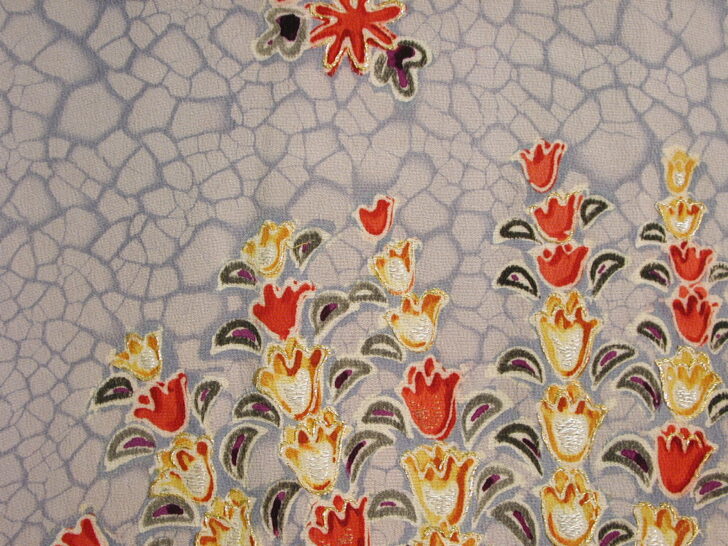Mauve and periwinkle crested haori with wax-resist designs of floral clusters and embroidery in metallic threads
Minagawa Gekka

Description
Gallery Rotation Spring/Summer 2012
Minagawa Gekka
Japan, 1892–1987
Haori
Showa period (1926–1989)
circa 1950
Crepe silk with colorful wax resist design and metallic thread embroidery
Gift of Howard and Patricia Yamaguchi, 2005/1.350
For much of the twentieth century, the haori has been the standard outerwear for a woman who dresses in a kimono outside of the home. The haori was originally part of a man’s formal attire, but in the nineteenth century, female entertainers in Edo (modern Tokyo) adopted it as a cloak for outdoor wear in mild weather. By the end of the century, upper-class married women had adopted black crepe silk haori with family crests for formal, public occasions. The owner of this haori, Shizuko Iwata (b. 1925), was a pioneering female executive in mid-twentieth century Japan, running a successful real estate business. She owned dozens of kimono, haori, and obi of the very finest quality, custom made for many different occasions, all in exquisite taste.
Subject Matter:
The haori was originally part of a man’s formal attire, but in the nineteenth century, female entertainers in Edo (modern Tokyo) adopted it as a cloak for outdoor wear in mild weather.
By the end of the century, married women of the upper class adopted black crepe silk haori with family crests for formal, public occasions. For much of the twentieth century, the haori has been the standard outwear for a woman who dresses in a kimono outside of the home. The owner of the haori, Shizuko Iwata, was a pioneering female executive in mid-twentieth century Japan, running a successful real estate business. Just as modern business women by power suits to express their authority and wealth, so did Shizuko Iwata: she owned dozens of kimono, haori, and obi of the very finest quality, custom made for many different occasions, all in exquisite taste.
Physical Description:
Overall wax-resist dyed pattern of crackled pale mauve on periwinkle ground, decorated with wax-resist dyed patterns of foral clusters in red, yellow, purple and white, and embroidery in gold, silver, and red metallic threads. White plain weave silk lining with wax-resist designs of fabric samples, predominantly red, blue, and gold. Silver and red red cords with tassles. Crest on the back of paired oak leaves (kashiwa) embroidered with gold couched threads and red and white bokashi silk thread.
Usage Rights:
If you are interested in using an image for a publication, please visit https://umma.umich.edu/request-image/ for more information and to fill out the online Image Rights and Reproductions Request Form.